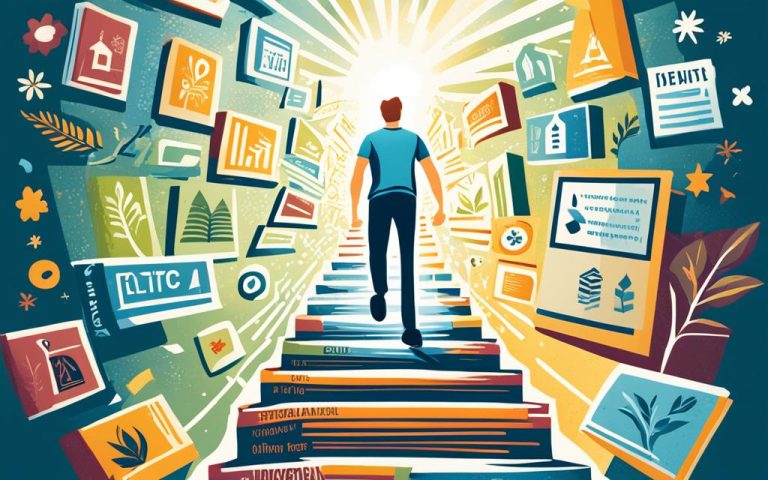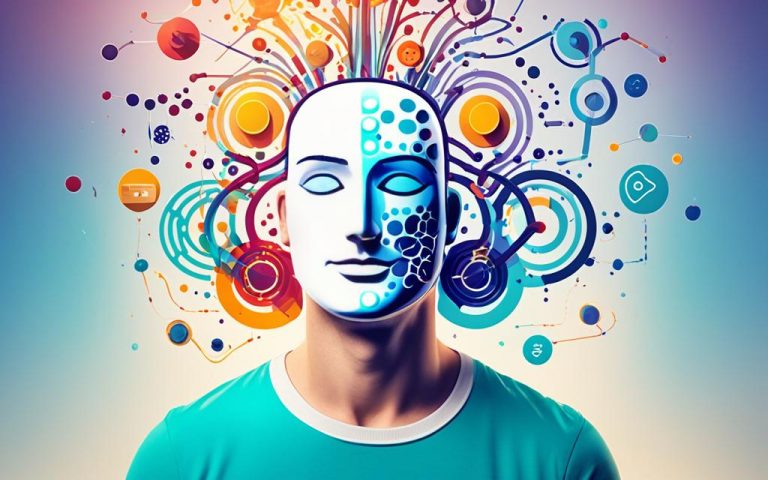Chat GPT’s Impact on Students: Navigating AI in Education
In education today, AI tools like Chat GPT are making a big change. They bring new chances and challenges for students. These tools, like Chat GPT, give students new ways to learn. They help with schoolwork but also raise worries about copying and what’s right or wrong.
Starting your learning journey means looking at how AI like Chat GPT affects you. This tech change can make you think more critically. It also changes how you and AI work together to learn.
Key Takeaways
- Chat GPT and AI writing tools offer personalized learning experiences and content creation assistance.
- Integrating AI into classrooms raises concerns about academic integrity and plagiarism.
- Ethical considerations and critical thinking skills are essential when navigating AI in education.
- The future of education may involve human-AI collaboration and redefining educator roles.
- Responsible AI integration balances technology benefits with preserving academic values.
Understanding the Rise of AI in Education
Artificial intelligence (AI) is growing fast, changing how we learn. It’s making education more personalized and creative. AI tools are now in classrooms, making learning more interesting for students.
The Evolution of Artificial Intelligence
AI has always fascinated researchers and dreamers. It started with symbolic AI and advanced to machine learning and deep learning. Today, we have powerful computers and tons of data, driving AI’s progress.
AI’s Growing Influence in Classrooms
In education, AI is everywhere. It fits each student’s needs, from personalized learning to writing help. Tools like ChatGPT assist in creating content and doing research.
AI-powered learning tools stand out in education. They use data to spot how students learn best. Then, they customize teaching to fit each student, boosting learning and grades.
Also, AI is making teaching easier, from grading papers to virtual tutoring. It’s making interactive lessons more common. With AI’s help, education might soon be completely personalized, fueling dreams and meeting unique goals.
Chat GPT’s Capabilities and Limitations
Chat GPT is a cutting-edge language model created by OpenAI. It grabs your attention with how well it can understand and create text that sounds like a person wrote it. This generative AI model uses complex natural language processing to interact with users and answer questions in a natural way. It serves as a handy tool for many needs, especially in education.
One big plus of Chat GPT is its vast array of knowledge. It knows about science, history, literature, and what’s going on in the world right now. This wide scope lets it join deep discussions and give useful insights across many topics, perfect for students looking for help with their work.
Moreover, Chat GPT is skilled at writing, summarizing, and translating text. It can produce clear and relevant content, which has implications for creative writing, crafting essays, and even coding. These possibilities point to a boost in both student creativity and work efficiency.
However, we should remember that Chat GPT and similar models have their limitations. They don’t truly understand things or think like humans do.
Even though Chat GPT mimics human writing very well, it does so by learning from large amounts of text. This method makes its answers possibly one-sided, incorrect, or harmful if the original data has bias or mistakes.
- Just using what AI like Chat GPT generates without fact-checking or critical thoughts can spread wrong information or promote cheating.
- It’s important to use Chat GPT with care, knowing what it can and can’t do.
- Everyone involved in learning or teaching should be aware of these AI limitations. This awareness helps in the proper and ethical use of such technologies.
AI Writing Assistance: A Double-Edged Sword
AI writing tools, like ChatGPT, bring a whole new level of help to students. These tools can make writing, researching, and creating easier. This lets students spend more time on thinking and showing their smart ideas.
Enhancing Productivity and Creativity
AI assistants help students tackle hard topics and pull ideas from many places. They make it easier to write clearly and open the door to interesting thoughts.
They also help in being creative. Students can work together on ideas. They get quick feedback that moves their work forward. This mix of human and AI skills can spark amazing work and make learning more fun.
Plagiarism and Academic Integrity Concerns
But, using AI tools without care can cause big problems. It might lead to not being honest about work, or even trying to pass off AI writing as their own.
It’s important for schools to guide students on how to use these tools right. They should have rules and tools to check for copying. This helps keep the work honest and teaches students how to be good writers in our tech-filled world.
| Potential Benefits | Potential Risks |
|---|---|
| Streamlined research and drafting processes | Potential misuse for academic dishonesty |
| Enhanced creative expression and idea exploration | Overreliance on AI-generated content |
| Focus on higher-order thinking and critical analysis | Lack of attribution and proper citation practices |
As AI tools get better, schools must make sure they’re used right. Using them well can help students grow and succeed. But, this must happen while being honest and following the rules of good writing and study habits.
Personalized Learning with AI
In modern education, personalized learning is becoming very important. It helps meet the unique needs of students. Thanks to adaptive educational systems using AI, teachers can give lessons that suit each student’s way of learning. This includes their strengths, weaknesses, and style.
Adaptive Learning Experiences
AI and data insights are changing how we teach one-on-one. The adaptive systems learn from how students do and what they like. Then, they adjust the learning experience in real time. This way, students get lessons that fit them perfectly, making learning more engaging and effective.
Addressing Individual Needs and Preferences
Old ways that fit all students often don’t work well. But, AI-based student-centered approaches can. These systems find the best way each student learns, whether it’s through seeing, hearing, or doing. This makes education truly personal, by focusing on what each student is good at and interested in.
Personalized learning is not just about getting good grades. When students learn in ways that they enjoy and understand, they become more motivated and confident. They learn better and keep wanting to learn more, which prepares them for life beyond school.
| Traditional Approach | Personalized Learning with AI |
|---|---|
| One-size-fits-all curriculum | Tailored content and pacing |
| Limited differentiation | Addresses diverse learning styles |
| Static instructional methods | Dynamic, data-driven adjustments |
| Generalized feedback | Personalized support and guidance |
As AI gets better, our approach to personalized learning can too. By using adaptive educational systems, teachers can help every student reach their full potential. This creates a passion for learning and prepares students for the future, no matter what it holds.
Chat GPT’s Impact on Students: Navigating AI in Education
The arrival of AI-assisted learning tools, like Chat GPT, marks a significant change in educational transformation. It changes how students learn and interact with school material. These tools are now more common, bringing big changes, both good and bad, that students need to manage.

Chat GPT and its AI friends offer simple ways to access a lot of information. They help students by explaining things in ways that fit them best. This makes learning better for everyone, regardless of how they usually learn. Plus, using AI can make finding information fast and easy, opening up time for other fun stuff.
But, it’s important to use AI smartly, so it boosts learning without replacing important skills.
Although, adding AI to schools does come with challenges. Some worry that students might use it too much, making work less original. And teachers might find their jobs changing, with AI doing some tasks for them. This could change how students and teachers work together.
- Know what AI can and can’t do.
- Make sure to use AI the right way, following ethical guidelines.
- Teach students and teachers about AI.
- Promote thinking, research, and using tech responsibly.
- Use AI as a helper, not as a full replacement for teaching.
Handling the Chat GPT student impact and AI in education calls for a careful plan. Teachers should welcome AI for its help, while keeping a close eye on learning the right way. This mix teaches students to be wise in a world filled with AI. They learn to keep their skills sharp, ready for work and life in the AI age.
Integrating AI into Educational Curricula
Today, AI is changing how we work in many fields. This makes it crucial to include AI in school courses. It helps students learn how to live and work in an AI-powered world. This is what we call AI literacy education.
Developing AI Literacy
Teaching AI concepts is key for students’ future success. It’s about showing them what AI is, its ethical side, and how it’s used in different areas. This knowledge helps them think critically. They learn to use AI right and spot any possible problems.
AI literacy is more than just coding. It’s about understanding AI’s impacts, chances, and needs, and knowing how to use it wisely.
Preparing Students for the Future Workforce
AI courses are also important for getting students ready to work later on. Many future jobs will need digital skills and working well with AI. With the right AI knowledge, students are prepared to find success in tomorrow’s job world.
Including AI in all subjects opens the door for more learning opportunities. For instance, students can use AI in science to handle big data, in language arts for analyzing text, or in social studies to understand AI’s effects on society.
| Subject | AI Integration Examples |
|---|---|
| Science | Predictive modeling, data analysis, simulation |
| Mathematics | Pattern recognition, optimization algorithms |
| Language Arts | Natural language processing, text generation |
| Social Studies | Ethical AI applications, societal impact analysis |
Bringing AI into education isn’t just about learning tools. It’s about teaching critical thinking for an AI future. This helps students use AI wisely and understand its impact better.
Ethical Considerations in AI-Assisted Education
AI-powered educational tools, like Chat GPT, are rising. We must look at the ethical considerations they bring. Otherwise, they might show algorithmic bias. This could keep societal biases or introduce new discrimination. Also, data privacy protection and cybersecurity risks are big issues. These tools might use and handle student data in a bad way.
Algorithmic Bias and Fairness
AI systems learn from a lot of data. This data can show the biases and unfairness already in our society. If we don’t stop it, these biases can continue or get worse. This could lead to unfair treatment or discrimination. For education, algorithmic bias could show up in tests that are not fair, suggestions for learning that are not right for everyone, or even language models that show prejudices.
To fix this, we have to make sure AI is fair. Schools and AI creators need to try and get rid of bias in their data and systems. They should check their work a lot and make sure their AI decisions are clear. Also, having a mix of people on the AI team can help make fairer AI solutions.
Data Privacy and Security
AI tools in education gather a lot of info about students, like their grades or how they learn. This makes data privacy protection very important. If this data isn’t handled right, it could lead to serious privacy issues, or someone might use it to harm students.
To tackle these problems, strong cybersecurity steps are needed. These include keeping data safe with things like encryption and only letting the right people see it. Schools should have good rules about data and make sure students and parents say it’s okay to use their info. Also, there should be laws to make sure AI uses student data in a safe and fair way.
Including ethical values and doing things the right way when making and using AI in education is not just about following the law or being good. It’s essential to make students, teachers, and society trust these technologies.
Fostering Critical Thinking in an AI-Driven World
Today, artificial intelligence (AI) is growing fast. It’s key to help students build critical thinking and analytical skills. These skills are important as AI starts to affect things like education more.
Developing Analytical and Problem-Solving Skills
Living in an AI world means students need strong analytical skills and problem-solving abilities. Schools should focus on tasks that make students think critically, see patterns, and solve complex issues. Doing group work, tackling real-life projects, and looking at case studies can all help.
Encouraging Independent Thought and Creativity
AI is great for doing simple jobs. But, human skills like independent learning and creativity are what makes us unique. Educators must encourage students to think freely, ask questions, and be creative. This is how students can stand out in an AI world.
When AI and humans work together in the classroom, great things can happen. AI helps by offering smart suggestions, making research easier, and doing repetitive tasks. This way, students can focus on thinking deeply, solving problems, and being creative.
As AI keeps growing, we must make sure students have the strong thinking skills they need. This will help them in a world where our ideas and new tech work together in a positive way.
The Future of Education: Human-AI Collaboration
With artificial intelligence rapidly improving, education is at a turning point. It’s poised to welcome human-AI collaboration as a game-changer. This shift will transform the roles of educators, leading to a teaching transformation. It will merge top-notch tech with human skills smoothly.
Redefining the Role of Educators
In the AI-only learning era, educators are shifting. They’re moving from giving out knowledge alone to guiding students’ custom learning paths. This means they’ll do more than just lecture. They’ll help students think critically, be creative, and learn life skills. Educators will find a balance. They’ll use AI’s strengths but also keep the human touch in the classroom experience.
Striking the Right Balance
As technologies like ChatGPT grow smarter, finding balance between AI and human interaction is key. AI can make teaching easier and more personal. But human educators are still crucial. They bring empathy, emotional smarts, and the power to motivate students. These are things machines can’t copy.
Educators need to see their new roles as guides and mentors. They should create a place where AI and human teaching work well together. This way, students will learn both social and emotional skills. They’ll be ready for a world that keeps changing. Achieving this balance will make the future of education filled with both human creativity and technological progress. It will prepare students to excel in the future.
Conclusion
As AI like Chat GPT changes education, we must use it wisely and responsibly. We face both new chances and challenges. We need to use AI well, keeping important values like thinking for ourselves and being honest in our work.
To prepare for an AI-filled world, schools must teach students certain skills and values. They need to learn how to think deeply, solve problems, and think on their own. Also, it’s important they understand how to use AI in a good way.
In the end, teaching about AI means caring for students, always learning, and doing what’s right. We should combine AI with our own creativity and thinking. This will help us get the best out of AI while keeping what makes education important.
FAQ
What is Chat GPT, and how is it impacting education?
Chat GPT is a smart language program by OpenAI. It can mimic human text. This tool can help students in multiple ways. Yet, it also makes people worry about cheating and honesty in their work.
How is AI transforming personalized learning experiences?
Adaptive AI learning systems customize how they teach to fit each student. This method boosts motivation and helps students remember knowledge better. Thus, it can lead to better school results.
What are the ethical considerations surrounding AI in education?
AI in education can bring up fairness issues and privacy concerns. To use AI well in school, we must focus on ethics. This means making sure it’s fair and safe for everyone involved.
How can educators foster critical thinking in an AI-driven world?
Teachers should help students build strong thinking and problem-solving skills. They should push for creative and independent work. Also, they should encourage students to work with AI to solve problems.
How might the role of educators evolve with the integration of AI?
With AI in the mix, teachers might become more like guides instead of just givers of knowledge. They will help students navigate learning with AI in a helpful way.
What steps can educational institutions take to prepare students for an AI-driven future?
Schools and colleges should teach students about AI and how to use it. They should keep an eye on jobs that use AI. And, they should make sure that using AI focuses on student growth, ethics, and never-ending learning.







